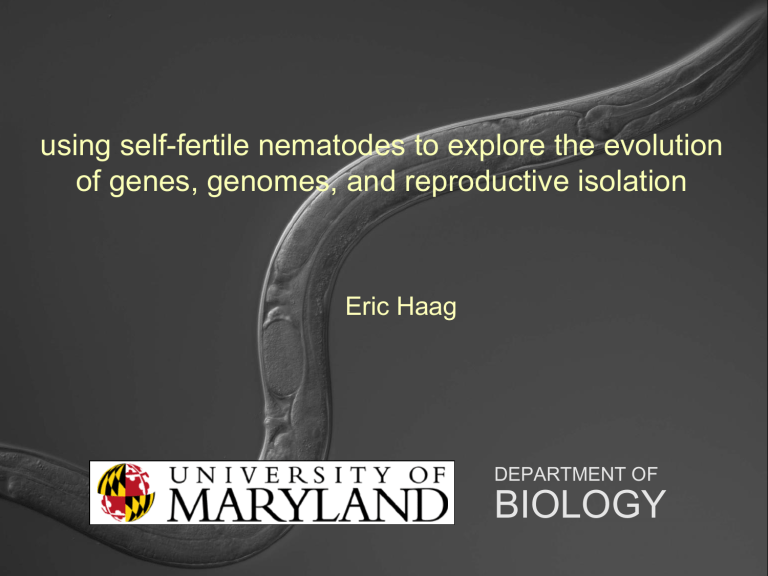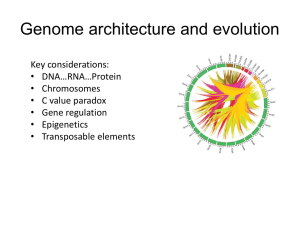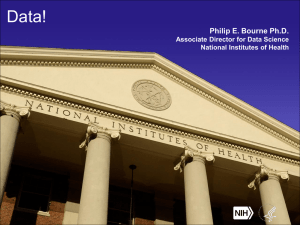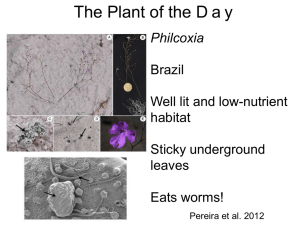C. briggsae - Homolog.us – Bioinformatics

using self-fertile nematodes to explore the evolution of genes, genomes, and reproductive isolation
Eric Haag
DEPARTMENT OF
BIOLOGY
reproductive diversity in free-living nematodes (Class Chromadorea)
Caenorhabditis Oschieus
D dioecious/gonochoristic
H selfing hermaphroditic
P parthenogenic
Pristionchus
Panagrolaimus
Denver et al. 2011
Caenorhabditis remanei: XX females, XO males
Cristel Thomas
self-fertile hermaphrodites : limited spermatogenesis in XX female soma
C. briggsae
XX young adult gonad
repeated evolution of selfing in Caenorhabditis transition to selfing gonochoristic ancestor
a model system for understanding convergent evolution
• How many different ways are there to produce a hermaphrodite?
• Once a lineage becomes selfing, are there reproducible consequences?
C. briggsae gonochoristic ancestor
genetic sex determination in C. elegans
How do XX hermaphrodites make sperm?
How C. elegans does it: translational repressors regulate germ line sex determination required for
XX sperm gld-1 fog-2
XO her-1 tra-2 tra-3 fem-1 fem-2 fem-3 tra-1
XX fbf-1/2 nos-3 limit XX sperm sperm
Kimble, Schedl Labs
C. briggsae shares core sex pathway…
• tra-1/2/3 perform conserved female-promoting roles
Kuwabara 1996, de Bono & Hodgkin 1996, Kelleher et al. 2008 (Haag and Pilgrim labs)
Cbr-tra-2 Cbr-tra-2
Kelleher et al. 2008
C. briggsae shares core sex pathway…
• fem genes perform conserved male-promoting roles in the soma
Hill et al. 2006 (Haag and Pilgrim labs)
Cbr-fem-3(nm63)
XO tail
• sperm-promoting targets of TRA-1 ( fog-1 & fog-3) also conserved
Chen & Ellis 2001 , Cho et al., 2004 (Ellis lab)
… but regulates XX spermatogenesis differently.
• fog-2 a recent duplication in C. elegans lineage —no C. briggsae ortholog
Clifford et al. 2001 , Nayak et al. 2005 (Schedl Lab)
• C. briggsae XX sperm also requires species specific F-box protein, she-1
Guo et al. 2009 (Ellis Lab)
• C. briggsae fem genes not necessary for XX spermatogenesis
Hill et al., 2006 (Haag Lab)
Cbr-fem-3(nm63)
XX (virgin)
• XX & XO spermatogenesis depends on Tip60 histone acetyl transferase activity
Guo et al. 2013 (Ellis Lab)
… but regulates XX spermatogenesis differently.
• fog-2 a recent duplication in C. elegans lineage —no C. briggsae ortholog
Clifford et al. 2001 , Nayak et al. 2005 (Schedl Lab)
• C. briggsae XX sperm also requires species specific F-box protein, she-1
Guo et al. 2009 (Ellis Lab)
• C. briggsae fem genes not necessary for XX spermatogenesis
Hill et al., 2006 (Haag Lab)
Cbr-fem-3(nm63)
XX (virgin)
• XX & XO spermatogenesis depends on Tip60 histone acetyl transferase activity
Guo et al. 2013 (Ellis Lab)
… but regulates XX spermatogenesis differently.
• fog-2 a recent duplication in C. elegans lineage —no C. briggsae ortholog
Clifford et al. 2001 , Nayak et al. 2005 (Schedl Lab)
• C. briggsae XX sperm also requires species specific F-box protein, she-1
Guo et al. 2009 (Ellis Lab)
• C. briggsae fem genes not necessary for XX spermatogenesis
Hill et al., 2006 (Haag & Pilgrim Labs)
Cbr-fem-3(nm63)
XX (virgin)
• XX & XO spermatogenesis depends on Tip60 histone acetyl transferase activity
Guo et al. 2013 (Ellis Lab)
… but regulates XX spermatogenesis differently.
• homologs play opposite roles, but have similar biochemical activities.
Beadell et al., 2011 (Haag Lab), Liu et al. 2012 (Haag & Wickens labs) sperm fate oocyte fate
Cbr-gld-1(nm68)
Ce-gld-1(q485)
Beadell et al. PNAS (2011)
• germline phenotypic evolution targets translational controls
• conserved & species-specific genes both important
• context changes roles of homologous genes
expected consequences of sexual mode facultative selfing
• replication of high-fitness genotypes
• reproductive assurance upon colonization
• maximal population growth (few males)
• genomes naturally homozygous —recessive deleterious alleles purged obligate outcrossing
• faster adaptation to new environments and pathogens
• recombination allows precise selection for/against new mutations
• must colonize in groups
• males reduce population growth
• genomes highly polymorphic —inbreed before sequencing?
other consequences we have noticed & explored
• mutational load and impact on genome projects
Ilya Ruvinsky, U. of Chicago
• reduced genome & transcriptome size
Barbara Meyer (Berkeley) Erich Schwarz (CalTech/Cornell) Brian Oliver (NIH
)
• evolution of sex-biased gene expression
Brian Oliver (NIH)
• “selfing syndrome” and reproductive isolation
Asher Cutter (Univ. of Toronto)
consequences we have noticed & explored
• impact on genome projects
Ilya Ruvinsky, U. of Chicago
• reduced genome & transcriptome size
Barbara Meyer (Berkeley) Erich Schwarz (CalTech/Cornell) Brian Oliver (NIH)
• evolution of sex-biased gene expression
Brian Oliver (NIH)
• relaxed sexual conflict and reproductive isolation
Asher Cutter (Univ. of Toronto)
apparent genome shrinkage in hermaphroditic species
Computational elimination of alternative alleles still leaves “extra” DNA and genes.
Is this real?
transcriptome size also correlates with sexual mode
Thomas et al. 2012
likely mechanism of genome shrinkage: indel segregation distortion in males
X
A
XX progeny
(smaller autosome)
XO progeny
(larger autosome)
Wang et al. 2010, Keller Lab
consequences we have noticed & explored
• impact on genome projects
Ilya Ruvinsky, U. of Chicago
• reduced genome & transcriptome size
Barbara Meyer (Berkeley) Erich Schwarz (CalTech/Cornell) Brian Oliver (NIH)
• evolution of sex-biased gene expression
Brian Oliver (NIH)
• relaxed sexual conflict and reproductive isolation
Asher Cutter (Univ. of Toronto)
comparing expression between XX and XO sexes
Significant sex-bias
Significant sex-bias over 10-fold
Thomas et al. 2012
comparing the comparisons
• Strong male bias more common than strong female bias in all species but, in C. elegans & C. briggsae:
• Lower proportion of strongly femalebiased transcribed
• Strongly male-biased transcripts less male-specific
Thomas et al. 2012
relaxed sexual regulation of “male genes”
>10X male-biased
Thomas et al. 2012
highly sex-biased C. remanei genes disproportionately absent from hermaphrodite genomes
2 test, compared to genes detected in C. remanei
* p < 0.05
** p < 0.01
*** p < 0.001
Thomas et al. 2012
consequences we have noticed & explored
• impact on genome projects
Ilya Ruvinsky, U. of Chicago
• reduced genome & transcriptome size
Barbara Meyer (Berkeley) Erich Schwarz (CalTech/Cornell) Brian Oliver (NIH)
• evolution of sex-biased gene expression
Brian Oliver (NIH)
• parallel loss of seminal peptides—orphan signaling molecules?
Josh Singer (UMD)
• sexual conflict and reproductive isolation
Asher Cutter (Univ. of Toronto)
Weak Inbreeder/Strong Outcrosser (WISO)
Hypothesis (Brandvain and Haig, 2005)
“In crosses between plants with differing mating systems, outcrossing parents are expected to “overpower” selfing parents. Prezygotically, such overpowering explains a common pattern of incompatibility, in which pollen from self-incompatible populations fertilizes ovules of self-compatible individuals but the reciprocal cross fails. Such conflicts may strengthen reproductive barriers between populations, contributing to speciation .”
Caenorhabditis is one of the few animal systems where WISO might also operate?
Ongoing collaboration with Asher Cutter lab suggests it does.
Speculations on sexual mode and macroevolution:
• Relaxed sexual selection in selfers may accelerate and/or reinforce reproductive isolation of newly selfing taxa.
• Genome shrinkage rapidly eliminates genes required to revert to robust outcrossing.
• Selfing species vulnerable to infrequent catastrophes, leading to group selection against selfing over long evolutionary time scales.
Caenorhabditis
Selfing: a deal with the Devil?
Oschieus
Pristionchus
Panagrolaimus
thanks!
•
Alana Beadell
• Qinwen Liu
•
Cristel Thomas
• Gavin Woodruff
•
Becca Matteson
• Da Yin
•
Cutter Lab (Univ. of Toronto)
• Meyer Lab (Berkeley)
•
Oliver Lab (NIH)
• Pilgrim Lab (Univ. of Alberta)
•
Ruvinsky Lab (U Chicago)
• Harold Smith (NIH)
•
Erich Schwarz (Cornell)
• Wickens Lab (Univ. of Wisconsin)
NSF-IOS NIH-NIGMS HHMI (undergrad fellowships)









